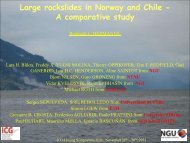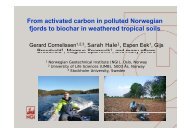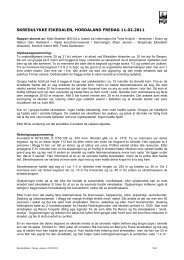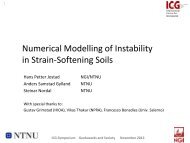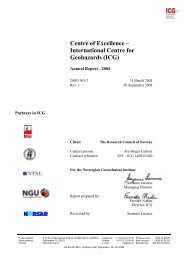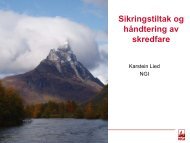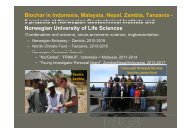Engineering Measures for Slope Stabilization
Engineering Measures for Slope Stabilization
Engineering Measures for Slope Stabilization
Create successful ePaper yourself
Turn your PDF publications into a flip-book with our unique Google optimized e-Paper software.
<strong>Engineering</strong> measures <strong>for</strong><br />
slope stabilization<br />
Giovanni Vaciago<br />
Studio Geotecnico Italiano , Milan, Italy
• Introduction<br />
CONTENTS<br />
• <strong>Measures</strong> to reduce the probability of landslides<br />
(stabilization s.s.)<br />
• Measure to intercept the run-out or protect elements at risk<br />
(control works)<br />
• Case histories<br />
2
2002 – 2012<br />
Congratulations and best wishes<br />
from the Italian Geotechnical Society<br />
to ICG on their tenth anniversary<br />
But first of all ….<br />
3
ACKNOWLEDGMENTS<br />
Much of the work presented here is based on Deliverable 5.1 of the<br />
SafeLand Project “Compendium of landslide risk mitigation measures”,<br />
(http://www.safeland-fp7.eu/results/Documents/D5.1.pdf) compiled by<br />
Studio Geotecnico Italiano with contributions from:<br />
• ICG of Norway, also responsible <strong>for</strong> quality assurance,<br />
• AMRA (a consortium of universities in Naples), Italy,<br />
• the University of Salerno, Italy,<br />
• Aristotle’s University of Thessaloniki, Greece,<br />
• Zurich Technical University , Switzerland<br />
• the University of Lausanne, Switzerland<br />
• the Geological Institute of Slovenia<br />
• the Geological Institutes of Romania<br />
The work was carried out as part of the EC 7th Framework<br />
Programme, under Grant Agreement No. 226479.<br />
4
Within a risk-based approach to landslide management, the classification of<br />
mitigation measures is usefully related to the terms of the “risk equation”<br />
R = (E)·(H·V)<br />
• <strong>Measures</strong> to reduce HAZARD<br />
• <strong>Measures</strong> to reduce VULNERABILITY to landslides<br />
• <strong>Measures</strong> to reduce the ELEMENTS at risk<br />
• Measure to SHARE RESIDUAL RISK<br />
INTRODUCTION<br />
“<strong>Stabilization</strong>” refers to the implementation of engineering works to reduce the<br />
probability of occurrence of landslides, i.e.: the Hazard.<br />
“<strong>Stabilization</strong>” sometimes (e.g.: Evangelista et al., 2008) used referring to the<br />
implementation of engineering works to intercept the run-out or to protect the<br />
elements at risk. Also referred to “Control works” (e.g.: Ambrozic et al., 2009).<br />
5
<strong>Slope</strong> stabilization measures operate by increasing the resisting <strong>for</strong>ces<br />
and/or by decreasing the driving <strong>for</strong>ces.<br />
They can be subdivided in relation to the physical process involved:<br />
• Surface protection and erosion control<br />
• Modifying the geometry and/or mass distribution<br />
• Modifying the surface water regime; surface drainage<br />
• Modifying the groundwater regime; deep drainage<br />
• Modifying the mechanical characteristics of the unstable mass<br />
• Transferring loads to more competent strata<br />
Retaining structures are described in the Compendium as an additional class<br />
of hazard mitigation measures, even though they do not address a specific<br />
physical process<br />
6
In so far as landslides are typically the result of several concurrent factors,<br />
it is often necessary to implement different stabilization measures.<br />
Appropriate measures will be selected taking into account:<br />
• factors which determine the Hazard: stratigraphy, mechanical characteristics<br />
of materials, surface and underground water regime, morphology, processes;<br />
• factors which affect the nature and quantification of Risk <strong>for</strong> a given hazard,<br />
such as the presence, vulnerability and value of elements at risk;<br />
• factors which affect the actual feasibility of specific mitigation measures:<br />
phase and rate of movement, accessibility, environmental constraints, preexisting<br />
structures and infrastructure, capital and operating cost, maintenance<br />
7
MEASURES TO<br />
REDUCE THE PROBABILITY OF LANDSLIDES<br />
(STABILIZATION S.S.)<br />
8
SURFACE PROTECTION AND EROSION CONTROL<br />
• Vegetation (hydroseeding, turfing,<br />
trees/bushes)<br />
• Fascines/brush<br />
• Geosynthetics<br />
• Substitution; drainage blanket<br />
• Beach replenishment; rip-rap<br />
• Dentition<br />
9
MODIFYING GEOMETRY AND/OR MASS DISTRIBUTION<br />
• Remove mass from area driving the landslide<br />
(possible substitution by lightweight fill).<br />
• Add mass to area maintaining stability, with<br />
or without gravity, cantilever, crib/cellular<br />
and/or rein<strong>for</strong>ced soil walls.<br />
• Reduction of the slope angle.<br />
• Scaling (removal of loose/unstable<br />
blocks/boulders)<br />
10
• Vegetation<br />
• Impermeabilization<br />
• Sealing tension cracks<br />
MODIFYING SURFACE DRAINAGE<br />
• Surface drains (ditches, piping) to<br />
divert flows from the slide area<br />
• Diversion channels<br />
• Check dams<br />
11
MODIFYING THE GROUNDWATER REGIME<br />
• Shallow or deep trenches with free-draining<br />
geomaterials and geosynthetics<br />
• Sub-horizontal drains<br />
12
MODIFYING THE GROUNDWATER REGIME (CNTD.)<br />
• Wells; self draining or drained by siphoning pumps<br />
13
MODIFYING THE GROUNDWATER REGIME (CNTD.)<br />
• Wells drained by base conductors<br />
14
MODIFYING THE GROUNDWATER REGIME (CNTD.)<br />
• Drainage tunnels, galleries, adits,<br />
with or without secondary drains<br />
15
MODIFYING THE MECHANICAL CHARACTERISTICS<br />
OF THE UNSTABLE MASS<br />
• Substitution<br />
• Compaction<br />
• Deep mixing with lime and/or cement<br />
• Permeation or pressure grouting<br />
with cementitiuous or chemical binders<br />
• Jet grouting<br />
• Modification of the groundwater<br />
chemistry<br />
16
TRANSFERRING LOAD TO COMPETENT STRATA<br />
• Shear keys: counter<strong>for</strong>ts,<br />
piles; barrettes (diaphragm<br />
walls); caissons<br />
17
TRANSFERRING LOAD TO COMPETENT STRATA (CNTD.)<br />
• Pretensioned<br />
multistrand anchors<br />
(with facing consisting<br />
of plates or beams)<br />
18
TRANSFERRING LOAD TO COMPETENT STRATA (CNTD.)<br />
• Passive anchors:<br />
soil nails; dowels,<br />
rock bolts; (with or<br />
without facing<br />
consisting of plates,<br />
nets, rein<strong>for</strong>ced<br />
shotcrete)<br />
19
TRANSFERRING LOAD TO COMPETENT STRATA (CNTD.)<br />
• Anchored walls<br />
(combination of anchors<br />
and shear keys)<br />
20
MEASURES TO<br />
INTERCEPT THE RUN-OUT OR<br />
PROTECT ELEMENTS AT RISK<br />
(CONTROL WORKS)<br />
21
MEASURE TO INTERCEPT THE RUN OUT OF<br />
FLOWSLIDES AND DEBRIS FLOWS<br />
• Diversion channels;<br />
• (Selective) Check dams, baffles;<br />
• Guide barriers/walls<br />
• Terminal barriers, basins<br />
22
MEASURE TO INTERCEPT THE RUN OUT OF ROCKFALLS<br />
• Vegetation on the slope<br />
• Catch trenches<br />
• Rockfall barriers<br />
• Rockfall nets (or drapery)<br />
• Rockfall sheds<br />
23
CASE HISTORIES<br />
24
A1 MILAN – NAPLES M/WAY – KM 315+000<br />
In the 1960s, following repeated landsliding on the southern flank of the<br />
original cutting the alignment was abandoned and the whole slope reprofiled.<br />
Following completion of the works, movement was observed in the N-bound<br />
c/way, requiring construction of stabilization measures in the 1990s.<br />
A1 to Florence<br />
N<br />
Alignment of original design<br />
Limit of reprofiling, 1960s<br />
<strong>Stabilization</strong> works, 1990s<br />
A1 to Rome<br />
25
A1 MILAN – NAPLES M/WAY – KM 315+000<br />
N<br />
26
A1 MILAN – NAPLES M/WAY – KM 315+700<br />
The embankment immediately to the SE of the underbridge failed during<br />
construction in the 1960s, possibly mobilizing in part pre-existing shear<br />
surfaces. The stabilization required the construction of an extensive toe fill.<br />
In the 1990s movement was observed to thr NW of the underbridge, requiring<br />
stabilization by Tee shaped barrets anchored at the top.<br />
A1 to Florence<br />
Limit of reprofiling, 1960s<br />
<strong>Stabilization</strong> works, 1990s<br />
High speed railway<br />
Roma-Florence<br />
A1 to Rome<br />
27
A1 MILAN – NAPLES M/WAY – KM 315+700<br />
28
A1 MILAN – NAPLES M/WAY – KM 342+000<br />
The Valdilago landslide occurred in 1966. Gabions were constructed along the<br />
local road uphill of the m/way.<br />
In the 1970s the newly constructed m/way started to show signs of distress.<br />
Following accumulation of over 40 cm of movement, the toe of the retaining wall<br />
was consolidated in the early 1980s by 20 m long, 1 m diameter stone columns.<br />
This slowed, but did not stop the movement<br />
A1 to Florence<br />
High speed railway<br />
Roma-Florence<br />
Stone columns, 1980s<br />
Barrettes & anchors, 2006<br />
A1 to Rome<br />
29
A1 MILAN – NAPLES M/WAY – KM 342+000<br />
The right bank of the Arno River was protected with drainage and rock armor<br />
after ongoing erosion of the bed and bank (1 m and 10 m respectively, in the<br />
period 1963 to 1984) was identified as the main cause of the slide. The river bed<br />
deepened by a further 1.4 to 1.5 m between 1984 and 2002.<br />
In fact, the area is located just downstream of the Levane dam, built in 1957 <strong>for</strong><br />
the production of electricity<br />
30
A1 MILAN – NAPLES M/WAY – KM 342+000<br />
The results of extensive inclinometer monitoring indicated that the landslide and<br />
the movement of the wall are not directly linked; the downhill portion moves at a<br />
much higher rate on a basal shear surface up to 20 m deep. Back-analyses<br />
confirmed fluvial erosion as the main “driver”.<br />
31
A1 MILAN – NAPLES M/WAY – KM 342+000<br />
The rate of movement indicated a possible progressive acceleration and<br />
broadening of the movement, with potential repercussions on the m/way. The<br />
area was there<strong>for</strong>e earmarked <strong>for</strong> additional stabilization and a final design was<br />
Indagine Integrativa 1a e 2a fase<br />
prepared in 2004 – 2005.<br />
s (mm)<br />
50.00<br />
40.00<br />
30.00<br />
20.00<br />
10.00<br />
0.00<br />
29/11/2001 29/03/2002 27/07/2002 24/11/2002 24/03/2003 22/07/2003 19/11/2003 18/03/2004<br />
data<br />
IG<br />
ID<br />
IE<br />
IF<br />
I1N<br />
I2N<br />
I4N<br />
32
A1 MILAN – NAPLES M/WAY – KM 342+000<br />
Based on a careful joint examination of the results of stability analyses and of the<br />
geotechnical monitoring it was possible to subdivide the area in two parts having<br />
significantly different rates of movement.<br />
Where the movement had progressed most (approximately 270 m), stabilization<br />
works consisted of a continuous 20 m deep free-draining diaphragm wall (porous<br />
concrete) supported by 30 m deep, 3x1m rectangular barrettes at 3 m spacing<br />
with a connecting slab and beam at the top, anchored by 40 m long strand<br />
anchors at 1.75 m spacing.<br />
Where movement was still in the initial stages and the shear strength of the clay<br />
had not deteriorated to the same extent (approximately 140 m), the existing<br />
retaining wall was anchored using two levels of strand anchors on a 2 x 1.5 m grid,<br />
applying the load through a new rein<strong>for</strong>ced concrete “skin” wall.<br />
The embankment, which over the years had been loosened by continued<br />
movement, was consolidated by systematic jet-grouting.<br />
33
A1 MILAN – NAPLES M/WAY – KM 342+000<br />
The worksite is clearly visible in the aerial photograph. To the left, the excavated<br />
soil in temporary storage be<strong>for</strong>e final disposal.<br />
34
A1 MILAN – NAPLES M/WAY – KM 342+000<br />
Construction of the porous concrete diaphragm wall<br />
35
A1 MILAN – NAPLES M/WAY – KM 342+000<br />
Construction of rein<strong>for</strong>ced concrete barrettes and connecting slab<br />
36
A1 MILAN – NAPLES M/WAY – KM 342+000<br />
Construction of ground anchors and new structural facing<br />
37
CHAMPLONG, NR. COGNE (AO)<br />
Unusually intense and prolonged rain<br />
on 13 to 16 October 2000 caused<br />
significant distress in all of the Italian<br />
NW Alps, including the Val d’Aosta<br />
region, resulting in widespread<br />
landsliding and flooding throughout<br />
the region.<br />
In Cogne, south of Aosta, the total<br />
rainfall during these 3 days amounted<br />
to approximately 65% of the average<br />
annual rainfall. Furthermore, it<br />
occurred after prolonged, albeit less<br />
intense rain in the previous month<br />
and was accompanied by rapid snow<br />
melting.<br />
Champlong<br />
Landslide<br />
38
CHAMPLONG, NR. COGNE (AO)<br />
A large, mainly roto-translational landslide (approx. 100.000 m3, 20 m deep)<br />
occurred near Champlong and Lillaz, approximately 2 km from Cogne.<br />
This type of landsliding is rather unusual in the valley, where rockfall,<br />
flowslides and avalanches are the common <strong>for</strong>ms of landsliding.<br />
Water jets were observed just be<strong>for</strong>e the slide, as confirmed by sand boils.<br />
39
CHAMPLONG, NR. COGNE (AO)<br />
The landslide moved as a series of<br />
“rafts”, tilting trees, disturbing the<br />
natural drainage of the area and<br />
obstructing the Urtier river, pushing it<br />
to erode the right bank.<br />
After the event, the area remained<br />
severely disrupted and unstable.<br />
40
CHAMPLONG, NR. COGNE (AO)<br />
Considering that the area lies within<br />
Italy’s oldest and most prominent<br />
National Park, the remediation had to<br />
strike a balance between:<br />
• returning the area to previous agropastoral<br />
and general amenity use;<br />
• preserving the new land <strong>for</strong>ms;<br />
• ensuring the stabilization of the<br />
area to prevent reactivations which<br />
could jeopardize the safety of the<br />
only motor road to Lillaz.<br />
Remediation and stabilization relied<br />
on reprofiling, surface drainage,<br />
erosion protection at the toe and<br />
reestablishment of vegetation.<br />
41
CHAMPLONG, NR. COGNE (AO)<br />
Ten years after the event the<br />
remediation is complete:<br />
realignement of the road on the right<br />
bank, erosion control works on the<br />
left bank, regrading, drainage and<br />
vegetation of the slide body.<br />
42
DEEP ROCKSLIDES IN THE ALPS<br />
Major rockslides on a catastrophic<br />
scale are quite common in the Alps.<br />
In 1987 the Coppetto (or Val Pola)<br />
landslide destroyed the villages of<br />
Sant’Antonio, Morignone and<br />
Aquilone, causing several casualties.<br />
The debris filled the valley bottom,<br />
blocking the main highway and the<br />
Adda River, which <strong>for</strong>med a landslide<br />
lake which threatened even greater<br />
devastation downstream.<br />
Eventually both river and road were<br />
diverted into tunnels to bypass the<br />
landslide.<br />
43
DEEP ROCKSLIDES IN THE ALPS<br />
The Ruinon landslide further up the<br />
same valley poses a similar hazard. It<br />
could <strong>for</strong>m a landslide dam on the<br />
Frodolfo stream and block the road<br />
which is the only full year access to<br />
Santa Caterina Valfurva, but it does<br />
not threaten any village.<br />
44
DEEP ROCKSLIDES IN THE ALPS<br />
The La Saxe landslide in Val d’Aosta<br />
poses a similar hazard. However, its<br />
run-out would cover most of the<br />
village of Entreves and it would block<br />
the access road to the Italian Portal of<br />
the Mont Blanc tunnel.<br />
by kind permission Prof. GB Crosta, Milan<br />
45
DEEP ROCKSLIDES IN THE ALPS<br />
While <strong>for</strong> the Ruinon landslide it would be sufficient to prearrange a road<br />
and hydraulic bypass, (and indeed this is what is currently planned), this<br />
would provide only marginal benefit in the case of the La Saxe landslides,<br />
due to the much greater potential impact on a built-up area and on<br />
critical infrastructure.<br />
The La Saxe landslide is also a good example of how the geological,<br />
hydrogeological and geotechnical detail influences the selection of<br />
stabilization measures.<br />
The landslide accelerates significantly in response to snow melt, when the<br />
piezometric levels rise above the failure surface (at around 70 m depth).<br />
This would seem to suggest that a drainage gallery could be highly<br />
beneficial <strong>for</strong> the stability of the landslide mass. However, moments<br />
continue, albeit slower, even in periods of the year when the piezometric<br />
levels lie below the failure surface, indicating that drainage alone would<br />
be insufficient to stabilize the slide.<br />
46
AND IF NOTHING ELSE CAN BE DONE ABOUT IT…..<br />
DANGER<br />
rock fall and<br />
landslides <strong>for</strong> 1.2 km<br />
in case of rain<br />
and heavy<br />
snowfall<br />
(By Order n.27 of 12/11/97)<br />
47
THANK YOU FOR YOUR ATTENTION<br />
!<br />
chestnut fall<br />
in autumn<br />
48
THANK YOU FOR YOUR ATTENTION<br />
49





